INDIAN ARMED FORCES CHIEFS ON OUR RELENTLESS AND FOCUSED PUBLISHING EFFORTS

The insightful articles, inspiring narrations and analytical perspectives presented by the Editorial Team, establish an alluring connect with the reader. My compliments and best wishes to SP Guide Publications.

"Over the past 60 years, the growth of SP Guide Publications has mirrored the rising stature of Indian Navy. Its well-researched and informative magazines on Defence and Aerospace sector have served to shape an educated opinion of our military personnel, policy makers and the public alike. I wish SP's Publication team continued success, fair winds and following seas in all future endeavour!"

Since, its inception in 1964, SP Guide Publications has consistently demonstrated commitment to high-quality journalism in the aerospace and defence sectors, earning a well-deserved reputation as Asia's largest media house in this domain. I wish SP Guide Publications continued success in its pursuit of excellence.
- Appointments Committee of Cabinet approves one-month extension in service of Chief of the Army Staff
- Admiral Dinesh K. Tripathi assumes Command of the Indian Navy as 26th Chief of the Naval Staff
- Prime Minister witnesses 'Bharat Shakti' – a Tri-Services Firing and Manoeuvre Exercise in Pokhran, Rajasthan
- Interim Defence Budget 2024-25 — An Analysis
- Union Defence budget 2024
- Prime Minister Modi Commemorates Indian Navy Day in a Grand Ceremony
India's Defence Budget 2017-18
The Finance Minister’s overall stated figure of Rs. 2,74,114 crore is, however, not what the Ministry of Defence (MoD) considers as India’s official defence budget. The difference amount between Finance Minister’s and MoD’s figures of Rs. 11,724 crore is allocated under what is considered Defence (Civil Estimates) which, inclusive of defence pension of Rs. 85,740 crore, does not form part of the official defence budget.
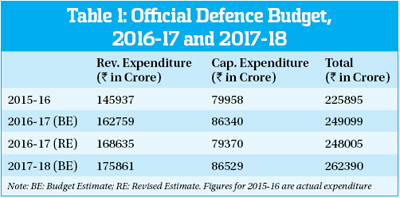
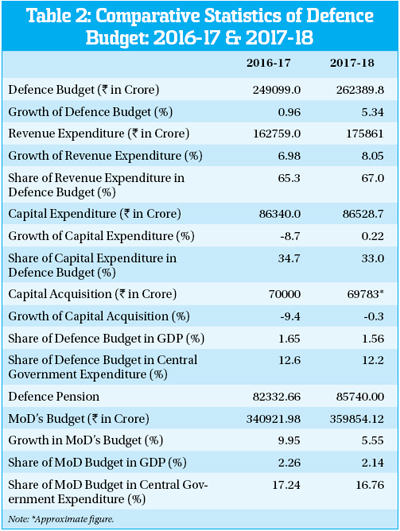

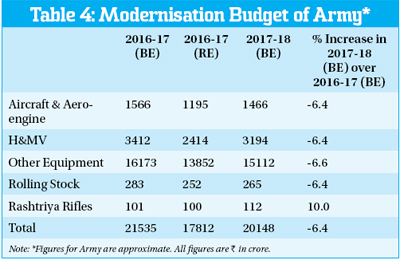
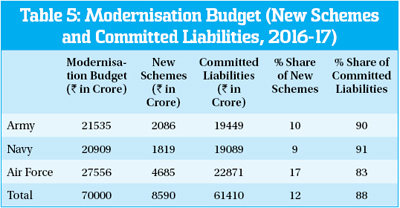
While presenting the union budget 2017-18 on February 1, 2017, Finance Minister Arun Jaitley allocated Rs. 3,59,854 crore ($55.36 billion) to the Ministry of Defence (MoD). Like in his previous budget, the Finance Minister also made certain changes in the format of the defence Demand for Grants (under which defence money is distributed among the armed forces and other defence agencies), bringing an element of further complexity of estimating various elements of what constitutes India’s official defence budget. The complexity apart, the bigger question that faces the defence community is whether the latest allocation is adequate to meet the security needs of the country. This article examines the latest defence allocation in the light of its possible impact on modernisation and operational preparedness of the defence forces.
Reconciling the Figures
While presenting the union budget to the Parliament, the Finance Minister stated that “for Defence expenditure excluding pensions, I have provided a sum of Rs. 2,74,114 crore including Rs. 86,488 crore for Defence capital.” The Finance Minister’s overall stated figure of Rs. 2,74,114 crore is, however, not what the Ministry of Defence (MoD) considers as India’s official defence budget. An attempt is made in Table 1 to reconcile the defence-related allocations provided in the union budget with the traditional format used by the MoD and compare it with the previous years’ allocation and expenditure. Using the MoD format, the defence budget for 2017-18 amounts to Rs. 2,62,390 crore. The difference amount (between Finance Minister’s and MoD’s figures) of Rs. 11,724 crore is allocated under what is considered Defence (Civil Estimates) which, inclusive of defence pension of Rs. 85,740 crore, does not form part of the official defence budget.
A noticeable aspect of the Table 1 is the underutilisation of capital allocations provided in the 2016-17 budget, resulting in a surrender of Rs. 6,970 crore (8.1 per cent). The surrendered amount has largely been absorbed in the revenue expenditure which has increased from its original estimates by Rs. 5,876 crore.
It is significant to note that the manpower driven defence budget is not unique to 2017-18. In the last several years, it has been a recurring feature with a debilitating effect on two vital elements of the defence budget revenue-stores and capital modernisation which together play a vital role in the operational preparedness of the armed forces.
The Highlights and the Major Trends
The Table 2 provides comparative statistics of defence budget and related figures for 2016-17 and 2017-18. The distinct noticeable feature of the table is the further decline in the defence budget’s share in both Central Government expenditure and the GDP. With a share of 1.56 per cent in the estimated GDP of 2017-18, the defence budget is the lowest since 1956-57.
What is of greater concern is that underutilisation has become a recurring feature of India’s defence budget, despite numerous improvements in the procurement procedures undertaken by the MoD in the past twoand-a-half decades
Another major feature of the Table 2 is the further increase in the share of the revenue expenditure in the total defence budget. The increase is primarily due to the hike in the manpower cost of the armed forces, which accounts for over 83 per cent ( Rs. 11,071 crore) of the overall growth of Rs. 13,291 crore in the defence budget. It is significant to note that the manpower driven defence budget is not unique to 2017-18. In the last several years, it has been a recurring feature with a debilitating effect on two vital elements of the defence budget revenue-stores and capital modernisation which together play a vital role in the operational preparedness of the armed forces. As the Figure 1 succinctly illustrates, the combined share of these two elements has declined from 55 per cent in 2007-08 to 40 per cent in 2016-17. This does not augur well, especially when there exists a huge void in India’s defence preparedness, and the armed forces have grave shortages in many areas ranging from ammunition, assault rifles, bullet-proof jackets, night-fighting devices to howitzers, missiles, helicopters, fighters and warships. Needless to say that for a credible defence preparedness, the present ratio needs to change for better for which allocation under revenue stores and capital modernisation needs to be augmented substantially.
Share of the Defence Services

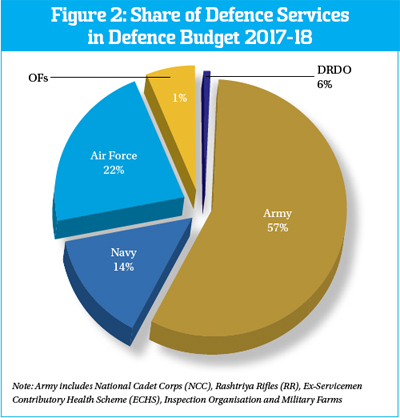
Among the defence services, the Indian Army with a budget of Rs. 1,49,369 crore accounts for the biggest share in defence budget, followed by the Air Force, Navy, Defence Research and Development Organisation (DRDO) and Ordnance Factories (OFs) (Figure 2). The biggest share of the Army is primarily because of its overwhelmingly numerical superiority over the sister services. Accounting for over 85 per cent of the uniformed personnel, bulk of the Army’s budget goes into meeting the pay and allowances of the personnel. In 2017-18, only 17 per cent of Army’s total allocation is earmarked for capital expenditure. The comparative figures for the Air Force and Navy are 58 per cent and 51 per cent, respectively.
Impact on Modernisation
Table 3 provides the modernisation budget of the three forces whereas the Table 4 shows separately for the Army. As can be seen, the overall allocation made in 2017-18 budget has declined, although marginally, over the previous allocation. Among the three forces, Air Force is the only service whose modernisation budget has increased whereas both the Army and Navy have witnessed a decline in their respective budgets.
What is of greater concern is that underutilisation has become a recurring feature of India’s defence budget, despite numerous improvements in the procurement procedures undertaken by the MoD in the past two-and-ahalf decades.
The decline in the modernisation budget is a source of great concern, especially given the limited budgetary scope available for signing new contracts. In 2016-17, only 12 per cent of the total modernisation budget of Rs. 70,000 crore was available for signing new schemes, with the rest being earmarked for the committed liabilities arising out of contracts already signed (Table 5). It is, however, to be noted that this limited scope has not been fully exploited as there has been an underutilisation of a whopping Rs. 7,393 crore (10.5 per cent). The underutilisation is across the services, although the Army accounts for over 50 per cent of total unspent funds. What is of greater concern is that underutilisation has become a recurring feature of India’s defence budget, despite numerous improvements in the procurement procedures undertaken by the MoD in the past two-and-a-half decades. Given that steady modernisation is a prerequisite for building up a strong military capability, the MoD has a big task ahead to bring in efficiency and expeditiousness in the procurement process.
Make in India and Defence Production
Unlike in the previous budget, the union budget has not provided any specific incentives to push the ‘Make in India’ initiative in the defence sector, although some industry-wide proposals have been promised. Among others, the government has promised to reduce income tax from present 30 per cent to 25 per cent for Micro, Small and Medium Enterprises (MSMEs) with an annual turnover of up to Rs. 50 crore. This is likely to benefit some 6,000 MSMEs which are presently supplying parts, components and subsystems to players like DRDO, defence public sector undertakings, ordnance factories and the large private companies.
There is a need to augment substantial resources, particularly under two critical heads of the defence budget — stores and capital procurement — which have come under severe pressure in the last several years with a huge negative consequence on India’s defence preparedness
The lack of any specific incentive for the defence industry may be a source of disappoint, as industry has repeatedly demanded certain concession which are extended to other sectors. In the union budget itself, the Finance Minister extended the ‘Infrastructure Status’ to the ‘Affordable Housing’, sector, allowing the industry in that sector to avail certain tax-related benefits. Needless to say, Infrastructure Status is one of several demands long requested by the defence industry.
Within the defence budget, however, there has been a small allocation of Rs. 44.63 crore made for porototype development under the ‘Make’ procedures which have recently been revised by the MoD and some 23 projects have been identified for execution. Of the total amount, Rs. 30.08 crore is earmarked for Army and the balance Rs. 14.55 crore for the Air Force.
Conclusion
The meagre increase of 5 per cent in the official defence budget is grossly inadequate especially in view of the vast void existing in military capability and the latest budget’s negative incremental effect on modernisation and operational preparedness. There is a need to augment substantial resources, particularly under two critical heads of the defence budget — stores and capital procurement — which have come under severe pressure in the last several years with a huge negative consequence on India’s defence preparedness.
From the MoD’s perspective, while the demand for higher resource is a genuine one, it must also be fully geared up to utilise the available resources in a time-bound manner. There is hardly any merit in asking for more resources while the present capacity to utilise the available resources, particularly those under the capital head, is constrained. The defence establishment must, therefore, look inward and find lasting solutions to procurement impediments. At the same time, the MoD also needs to look at the current profile of defence budget and find out any scope for controlling manpower cost so as to allow other items of expenditure to grow in a healthy manner.





